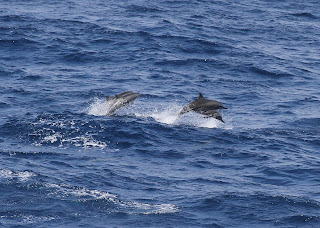The first of my three planned trips to Gibraltar this year was at the
start of the spring migration from 16-21 Feb 24. Due to Gibraltar being on the
east side of the Bay of Gibraltar and to the northeast of the Strait of
Gibraltar, westerly winds are required for any significant raptor movement to
be seen over ‘The Rock’. Easterlies result in raptors being mostly observed as
distant specks as they drift towards Spain as they head north across the strait
with Tarifa, on the southern tip of Spain, being significantly closer to Africa
than Gibraltar. Consequently, the 16th, being the only day with
westerlies, was my best opportunity to connect with Black Kite which was a
species already on the move. Despite the light westerlies far more Black Kites
were seen heading over Spain than close to / over Gibraltar itself.
 |
Hoopoe, Europa Foreshore, Gibraltar – 16 Feb 24
|
Apart from a day trip into Spain on the 20
th the daily routine
comprised of me accompanying fellow Amigo Slasher on net rounds from dawn until
late morning once any birds moving through had moved on. Due to the easterlies
the afternoons were spent visiting local birding hotspots such as North Front Cemetery, Western Beach, Europa Foreshore, etc. Consequently, I soon got to add the
local resident species not normally found in the UK to the Trip List that
included Hoopoe, Mediterranean Shag, Sardinian Warbler, Blue Rock-thrush,
Red-rumped Swallow, Balearic Shearwater, Black Kite (40+), Yellow-legged Gull,
Barbary Partridge, Eurasian Crag Martin and Spotless Starling.
 |
| Europa Point, Gibraltar – 16 Feb 24 |
The 20th was an even earlier start to get my lift with local birder and
photographer Steve Morgan for a full day of birding across the border. Fortunately,
there were no ‘shenanigans’ at the border crossing and we had a thoroughly
rewarding day visiting the inland lagoons at Barbate, the Northern Bald Ibis
colony (reintroduced and separate Blog entry to follow) at La Barca de Vejer, La
Janda wetlands and the Griffon Vulture colony in the hills above Bolonia. Highlights
included: Northern Bald Ibis, Audouin’s Gull (10), Black Kite (regular overhead
heading north), Black-winged Stilt (scores), Caspian Tern (2 singles), Osprey,
Spanish Sparrow, Corn Bunting (regular), Crested Lark, European Serin,
Fan-tailed Warbler, Thekla Lark, Greater Flamingo (c150), Stone Curlew, White
Stork, Black-winged Kite, Common Crane (c380) and Iberian Green Woodpecker (now
split). Great White Egret and Eurasian Spoonbill would previously have also been
included but both are now resident in Hampshire and regularly seen.
 |
| Northern Bald Ibis, Barbate, Spain – 20 Feb 24 |
 |
Audouin’s Gull, Barbate, Spain – 20 Feb 24
|
 |
Osprey, Barbate, Spain – 20 Feb 24
|
 |
Greater Flamingo, Barbate, Spain – 20 Feb 24
|
 |
| Eurasian Stone Curlew, Barbate, Spain – 20 Feb 24 |
 |
| Black-winged Kite, La Janda, Spain – 20 Feb 24 |
 |
| Griffon Vulture, Bolonia, Spain – 20 Feb 24 |
Good
birding,
Tony T BSc (Hons) GeoSci (Open)












































